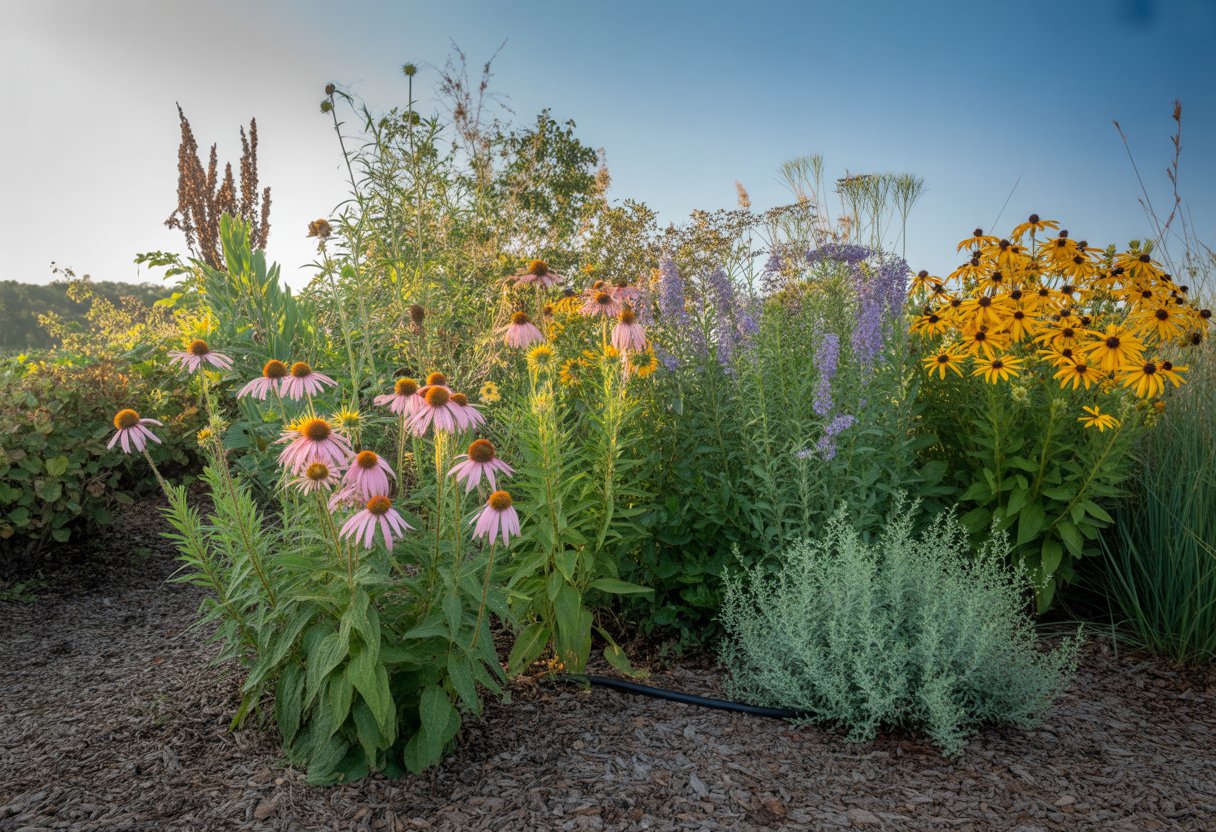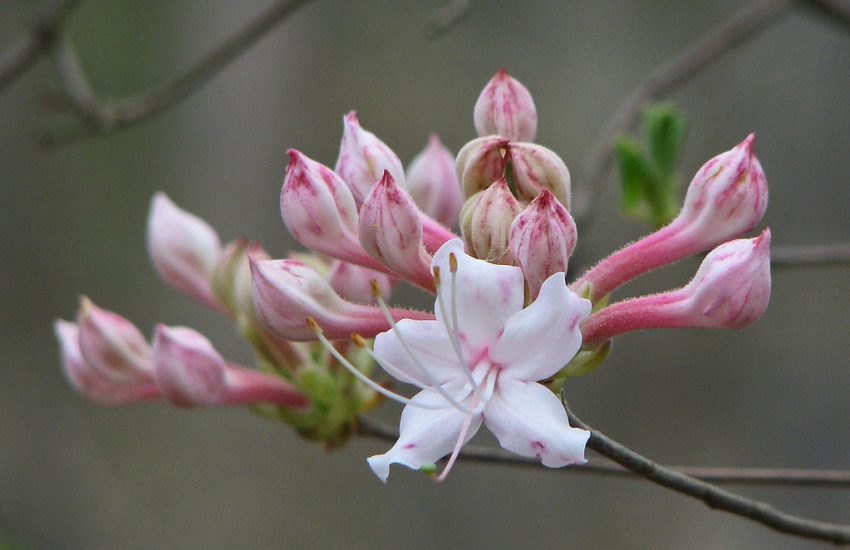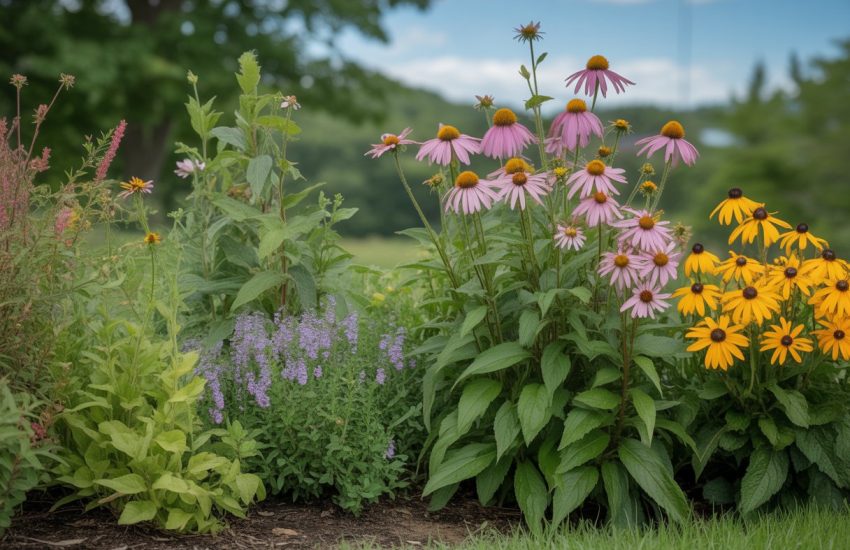Drought Tolerant Native Plants North Carolina for Sustainable Landscaping and Water Conservation
North Carolina’s climate can be unpredictable, swinging between lush rain and stubborn dry spells. If you want a garden that doesn’t wilt at the first sign of drought, native plants are your best bet.
These plants grew up here—they know how to handle the local weather. They need less water, shrug off drought, and honestly, they’re a lot less needy than some of those fancy imports.

Drought tolerant native plants in North Carolina conserve water while supporting local ecosystems, making them a smart choice for sustainable landscaping. They fit right in with the region’s soil and weather, so your garden keeps looking good, even when rain is scarce.
If you’re hoping to cut back on watering but still want a garden with real personality, you’ll find plenty of native species that thrive in dry conditions. Knowing which ones can handle drought makes planning way less stressful.
Understanding Drought Tolerance and Native Plants
Drought-tolerant plants don’t panic when the rain stops. They hang in there, needing only a little water to keep going.
Native plants in North Carolina have figured out how to live with the region’s climate, soil, and water patterns. This makes them a no-brainer for gardens where water isn’t always a sure thing.
What Makes a Plant Drought Tolerant
A drought-tolerant plant knows how to save water and use it wisely. You’ll notice things like deep roots, tough leaves, and sometimes a slower pace of growth.
These features help them soak up water when it’s there and lose less when it’s not. Some will even take a break during the hottest, driest spells—kind of like hitting pause until the rain comes back.
In North Carolina’s USDA zones 6-8, these tough plants handle unpredictable rainfall and the occasional bone-dry summer without falling apart. Take Eastern Redbud or Yucca filamentosa—they just keep going, even when water’s low.
Benefits of Native Plants in North Carolina
Native plants work with the local climate and soil, so you won’t have to drag the hose out as often. They give pollinators and wildlife a place to hang out, which is pretty great for the ecosystem.
They also keep soil healthier by holding it in place and helping it hold onto nutrients. Less fertilizer, less watering—sounds good, right?
Pests and diseases that knock out other plants usually don’t bother natives as much. That means fewer chemicals and less fuss for you.
Climate and Water Restrictions in North Carolina
Summers here get hot and sticky, but droughts still happen. When they do, non-native plants often struggle.
Water restrictions sometimes kick in, so you can’t always water when you want. In USDA zones 6-8, gardeners really need species that don’t wilt in the heat or dry out when water gets scarce.
Choosing native, drought-tolerant plants isn’t just good for your water bill—it helps you stay ahead of the next dry spell.
Top Drought Tolerant Native Plants for North Carolina
These plants don’t mind the heat or dry spells. They bring color, texture, and life to your yard, all without guzzling water.
Gaillardia pulchella: Blanket Flower
Gaillardia pulchella, or blanket flower, is about as easygoing as it gets. It loves full sun and even poor, sandy soils.
You get bold red and yellow blooms from early summer into fall, and bees and butterflies can’t resist them. Thanks to deep roots and a tough attitude, blanket flowers barely need watering after they’re settled in.
Pests and diseases don’t seem to bother them, either. If you’re aiming for a sustainable, no-fuss garden, this one’s a keeper.
Echinacea: Coneflower
Echinacea (coneflower) grows wild across North America and handles North Carolina’s dry spots with ease. The blooms are big, bold, and come in pink, purple, or white.
Coneflowers like sun and well-drained soil, and they’re magnets for bees and butterflies. They get along well with Rudbeckia hirta (black-eyed Susan), which is just as tough and colorful.
Mix them with yarrow or strawberry bush, and you’ll have a garden that looks good even when it’s dry.
Essential Growing Conditions and Garden Planning

Pick the right spot and get your soil ready—these steps make all the difference for drought-tolerant natives. Knowing your local climate and soil helps plants settle in and survive the dry times.
Understanding Hardiness Zones and Growing Season
North Carolina covers USDA hardiness zones 6a to 8a. Most drought-tolerant natives prefer zones 7a to 8a, which are common in the Piedmont and Coastal Plain.
The growing season runs from mid-March through late October, depending on where you are. If you plant early in spring—before the last frost—you’ll give your plants a head start.
Stick with natives suited to your zone. They’ll handle the heat and drought much better than outsiders.
Soil Recommendations: Well-Drained and Native Soils
Drought-tolerant plants need soil that drains well. Standing water is a big no—roots will rot fast.
Sandy loam or clay loam with decent drainage works well in most of the state. You want soil that keeps some moisture but doesn’t get soggy.
Test your soil before planting. You might need to add a bit of organic matter or sand if water pools up.
Keeping native soil helps good microbes stick around, which is better for your plants. Don’t go overboard with fertilizer—too much lush growth just makes things thirstier.
Group plants with similar water and soil needs for easier care. Mulch helps, too; it keeps roots cool and holds in moisture.
Supporting Pollinators and Water Conservation

Drought-tolerant native plants don’t just save water—they help pollinators, too. Less irrigation means you’re doing your part for water conservation, especially when the heat’s on.
Mixing pollinator-friendly natives with smart watering habits makes for a garden that’s both tough and beautiful.
Attracting Native Pollinators to Your Garden
Plants like purple coneflower (Echinacea purpurea), black-eyed Susan (Rudbeckia hirta), and bee balm (Monarda didyma) are basically pollinator magnets. They bloom at different times, so bees and butterflies always have something to snack on.
If you want more pollinators, plant a mix of flower shapes and colors. Skip the pesticides—pollinators don’t need that.
Leave a few bare patches for ground-nesting bees and let some seed heads stay for the wildlife. It’s not just about water; it’s about making your garden a real home for nature.
Implementing Waterwise Garden Strategies
Waterwise gardening leans on techniques like mulching, drip irrigation, and grouping plants with similar water needs. These approaches really help cut down on water waste.
Mulching with organic materials keeps soil moisture in place. It also blocks a lot of that surface evaporation when the weather gets brutal.
Choosing native, drought-tolerant plants means you won’t have to water as much. Drip irrigation sends water right to the roots, so you get more bang for your buck.
If you group plants by how much water they need, you can target your irrigation without much guesswork. That way, you avoid overwatering and the dreaded runoff.


